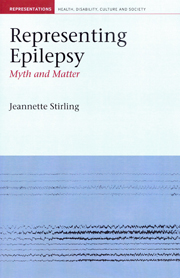Book contents
- Frontmatter
- Contents
- Acknowledgements
- Introduction
- 1 From Hippocrates to Shakespeare and Dickens: epilepsy's entry into ‘the circuit of culture’
- 2 Hystericity and hauntings: the female and the feminised
- 3 Notes from the borderlands: repressing the returned
- 4 The colonies
- 5 Because you're ‘you know. That way’
- Where to next? The ongoing story of epilepsy
- Bibliography
- Index
1 - From Hippocrates to Shakespeare and Dickens: epilepsy's entry into ‘the circuit of culture’
- Frontmatter
- Contents
- Acknowledgements
- Introduction
- 1 From Hippocrates to Shakespeare and Dickens: epilepsy's entry into ‘the circuit of culture’
- 2 Hystericity and hauntings: the female and the feminised
- 3 Notes from the borderlands: repressing the returned
- 4 The colonies
- 5 Because you're ‘you know. That way’
- Where to next? The ongoing story of epilepsy
- Bibliography
- Index
Summary
If I wished to show a student the difficulties of getting a truth from medical experience I would give him the history of epilepsy to read.
(Oliver Wendell Holmes, ‘Currents and counter-currents in medical science’, 1911)At the dawn of medicine's engagement with seizure conditions, Aretaeus proclaimed ‘Epilepsy is an illness of various shapes and horrible’. Over 2,000 years later, the medical descendants of Hippocrates and Aretaeus shouldered the task of trying to understand this most puzzling of chronic neurological conditions with renewed vigour. The closing decades of the nineteenth century saw the emergence of neurology as a specialist medical discourse. Committed to moving beyond the rather bleak epilepsy stories bequeathed them by their predecessors, these latter-day physicians determined to cultivate an innovative system of representation specific to their areas of concern. The hope was that a formalised and technical system of representation would allow them to modernise epilepsy and create stories that would bring it into a new scientific age.
By the 1880s the profession had gone some way in the quest to develop a contemporary lexicon to describe and record patients' symptoms so that they accorded with a range of evolving neurological taxonomies. Medical practitioners were encouraged to use standardised forms to record the outward signs of epileptic seizures, recovery times, postseizure mental states, vital signs, reflexes and so on.
- Type
- Chapter
- Information
- Representing EpilepsyMyth and Matter, pp. 1 - 35Publisher: Liverpool University PressPrint publication year: 2010



